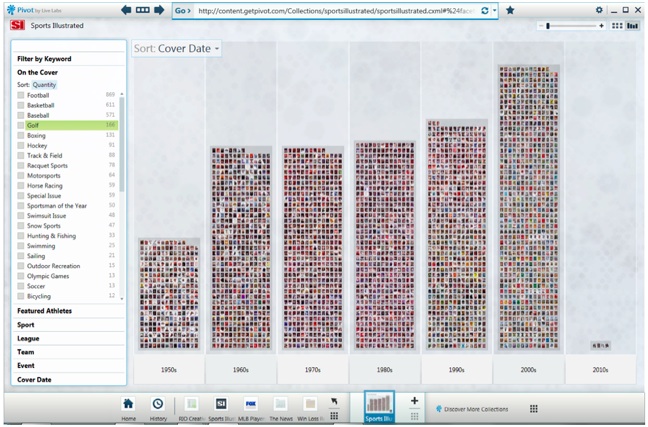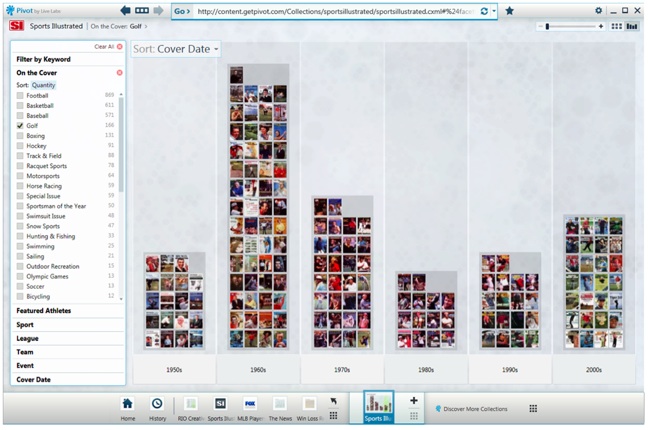 Editor’s note: This story is part of our Microsoft-sponsored series on cutting-edge innovation. Brett Brewer is general manager of Microsoft Live Labs, a group of scientists, engineers and entrepreneurs working to rapidly generate new Web technologies.
Editor’s note: This story is part of our Microsoft-sponsored series on cutting-edge innovation. Brett Brewer is general manager of Microsoft Live Labs, a group of scientists, engineers and entrepreneurs working to rapidly generate new Web technologies.
The number of elements we all deal with onscreen every day is constantly growing. There’s content, ads, links, feeds, widgets, and on and on. The electronic world is creating a challenge that we all have to deal with — there’s way too much to take in — and user interfaces must evolve to keep up. Statistics guru Edward Tufte was right when he said “information overload is just bad design.” If you present data to users in the right way, they can understand massive amounts of visual information and gain real insights into their data, and even have fun doing it.
That’s an area we’ve been working hard on at Microsoft Live Labs. We’ve created an experiment called Pivot that offers a glimpse into potential methods for creating more value from the sea of information around us. It lets individuals view information in ways that expose trends and insights that aren’t readily apparent using today’s conventional Web navigation methods.
When we’re looking for something online today, the Web naturally leads you to single pieces of information. For example, if you were looking up information about cars, you may wind up on a Web page that contained details for a particular model. Looking at one car at a time provides insight into that model, but it would be nearly impossible to compare and contrast all the cars that are on the market today across categories like price or fuel efficiency. With an interface like Pivot, thousands of cars can be visualized at once, letting you compare the whole group by, say, MPGs or safety rating. You can immediately spot trends — like which manufacturers offer the best fuel efficiency for the price, or who makes the most hybrids — that would be nearly impossible to see the way we have the web organized today.
Here’s a quick idea of how it looks. Let’s start with a high-level view of Sports Illustrated covers since 1954.

Then narrow our search down to cover stories relating to golf.

We’re zooming into one Golf cover that previews the Masters. We can use the information about this cover to refine our search to those covers that reference Phil Mickelson.

Clicking on Phil Mickelson takes us to an expanded view of all covers related to him over the years.

This new kind of interface can dramatically alter how people will interact with Web content. Think back to when you watched the film Minority Report. As Tom Cruise manipulated the large amounts data and images on the screen using only gestures, he interacted directly with the content itself, not with the controls or menus we normally associate with applications. The idea of the “application” receded into the background. It was the content that was his focus, and it was by manipulating the content directly that he accomplished his tasks.
The most complicated control in Pivot is a checkbox. Most of the interactivity and navigation within Pivot is done directly on the content itself. This, in combination with faceted search filtering, allows for simple, engaging interaction patterns that can expose complex insights. The ability to seamlessly move from the many, to the few, to the one, and back to the many, with no penalty for exploring, becomes immersive and fun.
All of today’s major search engines have the capability to answer simple factual questions (e.g. weather, movie times, latest news, stock quotes) and use a small portion at the top of the results page to show the answer. They show the “tree”, but little indication of the surrounding “forest.” I may ask who the highest paid baseball player is and will get the factual answer, Alex Rodriguez; but I don’t get an easy capability to see the context around him, like “How much more does he make than his teammates?” or “Who’s the second highest paid player?” and “What other players were born in the Dominican Republic?” The ability to easily explore the context around the initial answer enriches the experience and creates a kind of living info graphic.
Another thing new interfaces will have to handle is the ability to interact with content from more than one web page at a time and to see the interrelationships between pages beyond the links we decide to click on. What if we could see, in one interface, both the hyperlinked connectivity between pages as well as how they semantically cluster with other pages? If I search for “Barack Obama” on Wikipedia, using Pivot, for example, I can see not only the primary page for the president, but also those pages that are semantically related, such as books about him or other Illinois Democrats (pictured below). By clicking through his main page, I see all outbound linked pages, but what’s also exposed are the most prevalent concepts within that set of pages, e.g. that President Obama is also a Time magazine Person of the Year. Note that the system is showing me information that isn’t contained in any one page in Wikipedia but that is exposed when you aggregate statistics across many related pages.

Finally, new interfaces will have to allow for huge amounts of visual information to be manipulated without the need to reload the page or click “next” on long, paginated lists. New technologies like Deep Zoom, which powers the Pivot experience, can deliver this seemingly infinite amount of information into a finite space. This technology allows Pivot to load thousands of ultra-high resolution images at once and even facilitates embedding extra details into each item. For example, we can look at the detailed brush strokes and techniques of the master artists or take an interactive tour of a whole museum’s worth of images.
At the end of June, Microsoft will be releasing a new version of Pivot called the Silverlight PivotViewer, allowing any website to embed this functionality directly on their own pages. This new Silverlight control will help bring a new type of navigation experience to a large audience starting this summer. Microsoft has been working with dozens of companies to prototype uses for this technology across a number of industries, from Web advertising to medical research to retail business intelligence to e-commerce and large image galleries. The possibilities are quite broad, and we think these early implementations are just beginning to scratch the surface of the technology’s long-term potential.
You can watch Gary Flake, the founder and director of Live Labs, demonstrate Pivot at this February’s TED 2010 conference, or try it yourself by downloading the application.
When we are able to easily see the patterns and discover new relationships and insights about our content, I believe we’ll embrace the ability to interact with more information at once in ways that are powerful, informative, and fun. The old adage that less is more will be challenged as we begin to prove that the whole can be greater than the sum of the parts.
Brett Brewer is general manager of Microsoft Live Labs. He has spent the last 12 years at Microsoft, working in field sales, Windows, Search, high performance computing, and labs groups. His specialties are in the areas of search, Web search relevance measurement and assessment, high-performance computing, and corporate innovation strategies. He holds multiple patents in the Web search industry.
Let us know if you agree with Brett. Take the poll below.
How will we handle the data deluge?Market Research
To read more recent stories in this series, click on one of the headlines below:
The subscription economy is here. Are you ready?
As new phones emerge, mobile app development is a moving target
A future of full of touchscreens? It’s all in the software
Cleantech’s next generation: smaller, nimbler, smarter
How JavaScript will lead the way to open video
TV 2.0: Hulu’s flatlining, and the networks are ready to innovate
What will it take to make mobile payments mainstream in the US?

